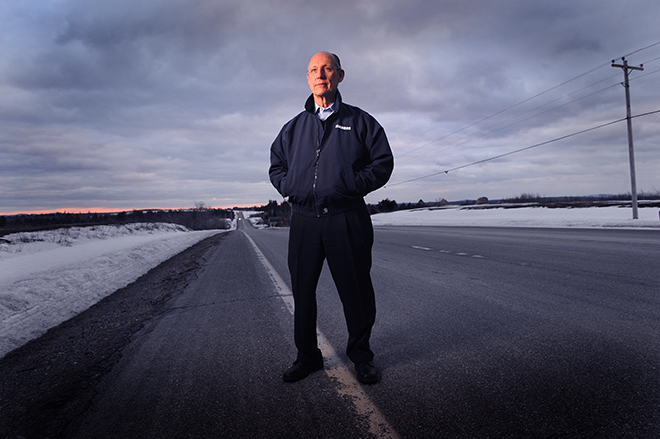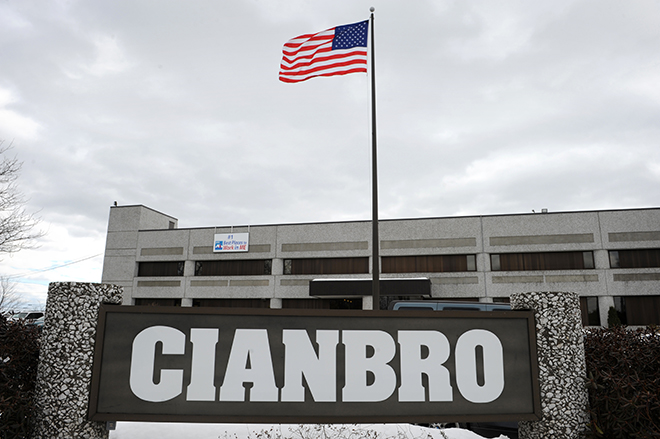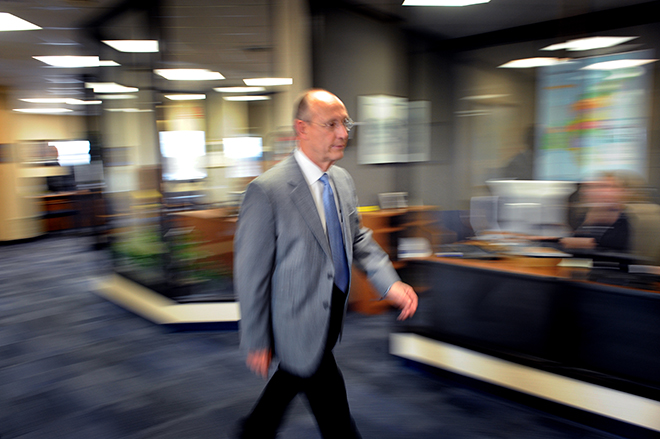Peter Vigue on Motivating Change + Mapping Maines Future
“Pete” Vigue, as pretty much every one of Cianbro’s 4,000 employees calls the ultimate boss at Maine’s largest construction company, is a modest man. As chairman and CEO of Cianbro’s diversified construction and business operations, one of his favorite sayings, emblazoned on the walls of the company’s conference room is, “No one is smarter than all of us.”
But for such a modest man, Pete Vigue also has some very big ideas that he would like you and me and everyone else in Maine to think about. By championing such ambitious proposals as a highway to cross the state from east to west, the use of I-95 as a corridor for energy transport, and Maine’s entry into offshore wind development, as well as advocating for a healthier society, Vigue has become identified as Maine’s leading business voice on our most pressing economic and social issues. Such a seamless mix of humility and ambition can make you think you might have just encountered a walking contradiction.
The one idea that has thrust Vigue into the spotlight of controversy, however, is the proposal to build a 220-mile private toll road from Calais across northern and western Maine to the Canadian border called the east-west highway. Many small businesses along the route, environmentalists, and some Tea Party Republicans hate the idea—each for different reasons. When I ask Vigue, who has become the project’s chief spokesman (and also its chief lightning rod), about this opposition, he is patient and understanding of the criticism, but undeterred. “We need to motivate people to understand the opportunity we have. It does not matter whether it is an east-west Highway or a railway,” he says. “It is all about connectivity.”
In Vigue’s analysis, Maine needs to transform its economic approach and transportation system to take advantage of changes in global trade. As a big-picture thinker, Vigue begins with observing that global trade depends on containerized transportation systems, which are the cheapest way to transport manufactured goods. He points out that Panama is deepening and widening its canal to handle larger ships that can carry more and more containers to increase trade.
Vigue and his team at Cianbro have carefully assembled research on port depths and capacities all along the Eastern Seaboard of the United States, including those of New York, Norfolk, Baltimore, Charleston, and Savannah, all of which are planning to increase their depth to at least 50 feet in anticipation of the expansion of the Panama Canal. All of these ports will need hundreds of millions, if not billions, of dollars of investment in infrastructure improvements to accommodate the new “Panamax” ships that can fit through the expanded locks, which could delay construction.
If and when other East Coast ports make improvements, however, Eastport will still be the deepest port in the continental United States and for less than $500 million, Vigue estimates, Maine could build a competitive port to attract a piece of this global trade. Of course, there is the issue of how you get the containers from point A (Eastport) to point B (the Midwest), which is how we get back to the east-west transportation corridor.
Vigue points out that the railroad right-of-way from Eastport to Ayres Junction still exists, where it could connect with Maine’s existing railroad system or to a private toll highway to transport products to America’s industrial heartland in the Midwest. Vigue passionately believes that increased trade, which depends on an integrated transportation system, is an important element of economic revitalization in Maine. He cites the example of Lemforder in Brewer, which made ball joints and steering components for car plants in the Midwest, “a huge facility, employing 400 people, that paid high wages, but left because of transportation.”

An east-west transportation corridor could be a combination of rail lines hauling bulk freight and interconnected highways, says Vigue.
Vigue also points to Lincoln Paper and Tissue—a tissue manufacturer that loads 160 trucks per week with its products, most of which go to the Midwest. These trucks head down I-95 and then west on interstates. “Trucks cost $125 to $150 per hour to operate and truckers have to stop every ten hours,” says Vigue. “So if deliveries take another day to day and a half to get there, you are talking real money.” Highways are good for transporting products that depend on “just-in-time” manufacturing schedules, while rails are good for transporting bulk material—wood, chemicals, liquids, and the like.
If Maine were to invest in an east-west transportation corridor with some combination of rail and road—since Maine has pieces of both—it would transform the future of the state. “The whole point is this is one example of how the state can advance itself,” says Vigue. “We think we are at the end of the road, but we have to change our perception…we think we are isolated and that’s just the way it’s going to be.” But this is not what Vigue sees. “It takes changing our mindset.”
Vigue has a long and successful history of changing mindsets at one of Maine’s largest companies. After growing up “economically challenged,” as he puts it, in Pittsfield, Vigue went off to Maine Maritime Academy and “went to sea for a while but didn’t find it challenging.” He had known the Cianchette brothers from his childhood in Pittsfield, where he delivered newspapers as a boy, and joined the company in 1970 on the Portland waterfront at an entry-level position. The company was relatively small then and he worked multiple positions, becoming a field engineer, estimator, project manager, and area manager. “I learned a lot from a lot of different people. All four Cianchette brothers were my mentors growing up in the business.”
In the 80s and 90s about 70 percent of Cianbro’s business in Maine involved construction projects for Maine’s pulp and paper mills, a notoriously cyclical industry (today, pulp and paper accounts for only five percent of Cianbro’s projects). In 1979, in order to expand Cianbro’s geographic footprint, Vigue was asked to move his family to the Washington, D.C., area, where he built a team to establish the company in the Virginia, Maryland, and D.C. markets. Vigue returned to Maine to become head of Cianbro’s purchasing department, then became vice president of operations before becoming president of the Cianbro Corporation in 1991.
A decade later, Vigue led the transition of the company into a 100-percent employee-owned structure. A trust now holds all of the stock for the benefit of all employees. “Everyone is an owner from day one,” says Vigue. “It’s a very unique situation and lines up with my personal philosophy.” Today, the Cianbro Companies are over ten separate companies operating under one umbrella; Vigue is chairman and CEO of the diversified enterprises.
Vigue has led the company not only into different geographic regions, but also into whole new industries. Perhaps the most innovative leap he took was in 2002, after a downturn in construction. A shipbuilding company on the Gulf Coast went bankrupt partway through the building of a pair of giant offshore oil-drilling rigs. Vigue convinced the company to let Cianbro bid on completing the project, even though they did not have any experience building oil rigs. The components of two rigs were towed to Portland, where the $100 million-plus contract project provided steady jobs for more than 1,000 Cianbro employees and subcontractors for a year and a half, when so many others in the business were going through lean times. “It took some convincing of our bonding and insurance carriers,” says Vigue, but Cianbro delivered on time and on budget, which added greatly to its growing reputation—and to Vigue’s.
Although Pete Vigue is a man of many accomplishments, he is perhaps most proud of the company’s safety record under his leadership. “We work in an industry considered to be very unsafe. The one thing we can do about it is to lead by example. Lead the way. We can do complex and difficult things without hurting people.” In 1987 the company set out to be the safest construction company in America—and became not just the safest construction company in the United States, but a company with one of the most astounding records in any industry—52 months and over 12 million work hours without a single lost workday. “Everyone goes home in the same condition they came to work in,” he says firmly.
Vigue’s vision for safety then expanded to include the health of all Cianbro’s “team members,” as he calls his employees. Vigue points out that, “Seventy-five percent of health cost comes about from self-induced behavior. Now, I know this is a very sensitive issue, but I have to ask, ‘Do we need more health care or do we need to get healthier?’ I know the difference.” Under Vigue’s leadership, Cianbro instituted a wellness program in 1996, with the goal of improving quality of life and reducing risky health behavior at the company.
As a result of its commitment to safety and health, Cianbro is recognized nationally for its safety and wellness programs and was awarded the 2004 American College of Occupational and Environmental Medicine’s Corporate Health Achievement Award as the “Healthiest and Safest Company in America” as well as the Wellness Council of America’s Well Workplace Award at the Platinum Level. I was pleasantly surprised, while sitting in the waiting area of Vigue’s modest office on the third floor of Cianbro’s office building, to be offered a selection of fruit and nuts. Vigue sums it up: “Crazy stuff we do as a construction company, but we have fun doing it.”
When Pete Vigue argues that Maine needs to change its mindset, whether it’s about our transportation system, economy, energy sources, health care, or social fabric, people are willing to listen because he has had such a notable record of focusing on challenges and changing people’s minds to view them as opportunities.

Sunrise in Aroostook County, a region Vigue believes an east-west highway would help revitalize.
A HUGE ECONOMIC TRANSFORMATION
Here’s the problem that Vigue is currently focused on: Maine is undergoing a huge economic transformation. “Not so long ago we had a tremendous future: our tax base was growing, our economy was growing, social programs were in less demand, and people were in a totally different frame of mind.”
Vigue recalls that Millinocket was once the second-wealthiest community in Maine per capita—second only to Cape Elizabeth. But places like Millinocket, along with all Maine’s northern towns, have seen huge erosion in economic activity, tax base, and population. “You can see it in empty stores and abandoned houses,” Vigue says. “Millinocket recently had over 73 tax-acquired houses that people abandoned because they could not be sold, and the banks have simply stopped acquiring them because they are liabilities they cannot sell.” Other communities, he points out, are going back to being unorganized territories. According to Vigue, in seven out of Maine’s 16 counties, death rates exceed birth rates. When death rate exceeds birth rate, people have to rely more on social programs, which increases the size and cost of government. Washington County has one-third the population of what it had 30 years ago.
“This state, for as long as I can remember, has never had an economic development strategy that defines the economic future for the state of Maine. The policy makers in Augusta link with the university system and the business community and say we are going to make investments, create policies, educate a generation, and build an infrastructure to support the strategy that transitions from one administration to another,” Vigue says; too many times leaders have the capacity to see the future, “but think it is not their job to do anything about it if it doesn’t directly affect their business.” I have to wonder: Is this the warm-up for a future stump speech?
In virtually every public interview Vigue has given during the past decade, he gets back to a couple of basic points. He is, by his own admission, “super-sensitive to the challenges Maine faces.” He acknowledges that he “has been gifted with opportunities, which is why I am so passionate about this state. Everyone should have that opportunity. That’s what drives me. I sincerely believe Maine can compete on an international basis, but it is going to require creativity, innovation, and most of all collaboration. We can succeed, but it begins with us. When we believe in ourselves and act on it, then others believe and start acting on it—that’s how you change the world.”
He pauses. And then, he asks the question he has been answering all along: “Why not Maine?”



























